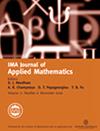低剂量牙锥束计算机断层扫描的非线性不适定问题
IF 1.4
4区 数学
Q2 MATHEMATICS, APPLIED
引用次数: 0
摘要
摘要本文描述了低剂量牙锥束计算机断层扫描(CBCT)的病态非线性逆问题的数学结构,并解释了基于深度学习的计算机断层扫描图像重建方法相对于传统正则化方法的优势。本文解释了为什么牙科CBCT比标准计算机断层扫描更病态的潜在原因。尽管存在这种严重的疾病,但由于其成本竞争力和低辐射剂量,对牙科CBCT系统的需求正在迅速增长。然后,我们描述了现有方法在使用金属种植体严重损坏的牙齿CBCT数据准确恢复牙齿形态结构方面的局限性。我们进一步讨论了由CBCT数据生成的全景图像对精确牙齿分割的有用性。我们还讨论了利用无辐射口腔内扫描数据作为CBCT图像重建的先验信息来补偿金属植入物对数据造成的损害的可能性。本文章由计算机程序翻译,如有差异,请以英文原文为准。
Nonlinear ill-posed problem in low-dose dental cone-beam computed tomography
Abstract This paper describes the mathematical structure of the ill-posed nonlinear inverse problem of low-dose dental cone-beam computed tomography (CBCT) and explains the advantages of a deep learning-based approach to the reconstruction of computed tomography images over conventional regularization methods. This paper explains the underlying reasons why dental CBCT is more ill-posed than standard computed tomography. Despite this severe ill-posedness, the demand for dental CBCT systems is rapidly growing because of their cost competitiveness and low radiation dose. We then describe the limitations of existing methods in the accurate restoration of the morphological structures of teeth using dental CBCT data severely damaged by metal implants. We further discuss the usefulness of panoramic images generated from CBCT data for accurate tooth segmentation. We also discuss the possibility of utilizing radiation-free intra-oral scan data as prior information in CBCT image reconstruction to compensate for the damage to data caused by metal implants.
求助全文
通过发布文献求助,成功后即可免费获取论文全文。
去求助
来源期刊
CiteScore
2.30
自引率
8.30%
发文量
32
审稿时长
24 months
期刊介绍:
The IMA Journal of Applied Mathematics is a direct successor of the Journal of the Institute of Mathematics and its Applications which was started in 1965. It is an interdisciplinary journal that publishes research on mathematics arising in the physical sciences and engineering as well as suitable articles in the life sciences, social sciences, and finance. Submissions should address interesting and challenging mathematical problems arising in applications. A good balance between the development of the application(s) and the analysis is expected. Papers that either use established methods to address solved problems or that present analysis in the absence of applications will not be considered.
The journal welcomes submissions in many research areas. Examples are: continuum mechanics materials science and elasticity, including boundary layer theory, combustion, complex flows and soft matter, electrohydrodynamics and magnetohydrodynamics, geophysical flows, granular flows, interfacial and free surface flows, vortex dynamics; elasticity theory; linear and nonlinear wave propagation, nonlinear optics and photonics; inverse problems; applied dynamical systems and nonlinear systems; mathematical physics; stochastic differential equations and stochastic dynamics; network science; industrial applications.

 求助内容:
求助内容: 应助结果提醒方式:
应助结果提醒方式:


